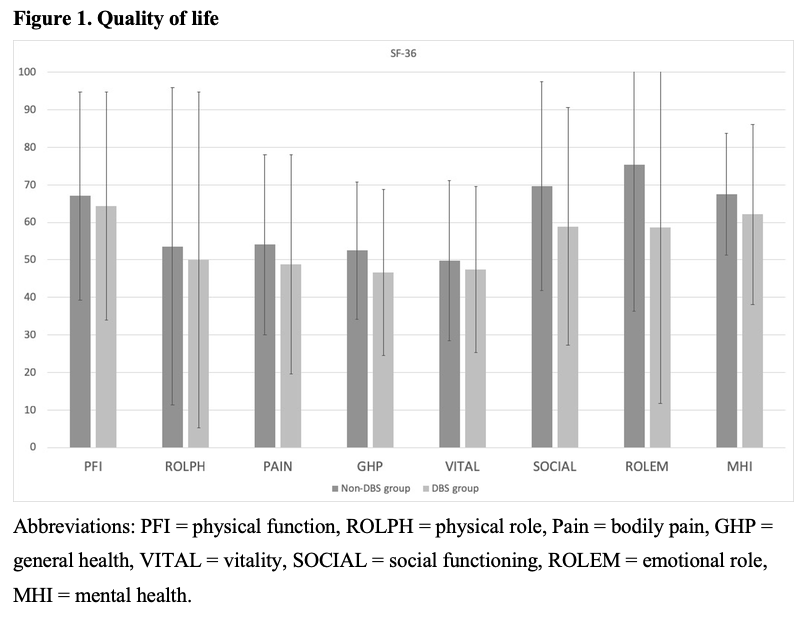Session Information
Date: Tuesday, September 24, 2019
Session Title: Dystonia
Session Time: 1:45pm-3:15pm
Location: Les Muses Terrace, Level 3
Objective: To evaluate motor and psychiatric symptoms as well as quality of life (QoL) in dystonia patients treated with botulinumtoxin/medication (non-DBS group) and deep brain stimulation (DBS) (DBS group) in a monocentric dystonia cohort.
Background: Dystonia is a movement disorder characterized by sustained or intermittent muscle contractions leading to abnormal postures or movements. Psychiatric comorbidities, e.g. depression and anxiety disorders frequently accompany motor symptoms and QoL may be impaired.
Method: 63 patients were enrolled in the study. Motor symptom severity was assessed with the Global Dystonia Rating Scale (GDRS) and the Burke-Fahn-Marsden Dystonia Rating Scale (BFMDRS). Psychiatric symptoms were evaluated with the Hospital Anxiety and Depression Scale (HADS-D), Beck Depression Inventory II (BDI-II), Liebowitz Social Anxiety Scale (LSAS) and the Patient Health Questionnaire 9 (PHQ-9). Quality of life was investigated with the Short Form 36 Questionnaire (SF-36).
Results: Patients in the DBS group were more severely affected by motor symptoms than patients in the non-DBS group (GDRS p = 0.023, BFMDRS p = 0.001)(Table 1). Depression and anxiety were overall frequent comorbidities, but there was no significant difference between groups (depression and anxiety frequency in non-DBS/DBS group: HADS-D 67%/67%, BDI-II 34%/29%, LSAS 50%/53%, PHQ-9 65%58%) (Table 2). QoL was impaired affecting all sub-items of the SF-36, but was not different between groups (figure 1).
Conclusion: Although patients in the DBS group had more severe motor symptoms than the non-DBS patients, there were no differences in the frequency of psychiatric symptoms and QoL impairment. Depression and anxiety had a high prevalence in our cohort, confirming results of previous studies. Our findings highlight the importance of treating not only motor but also non-motor symptoms in dystonia patients. The study was supported by the Dystract Consortium.
To cite this abstract in AMA style:
A. Maurer, U. Hidding, W. Hamel, C. Moll, C. Gerloff, M. Gelderblom, S. Zittel-Dirks. Comparison of motor and non-motor symptoms in operated and medically treated dystonia patients [abstract]. Mov Disord. 2019; 34 (suppl 2). https://www.mdsabstracts.org/abstract/comparison-of-motor-and-non-motor-symptoms-in-operated-and-medically-treated-dystonia-patients/. Accessed December 10, 2025.« Back to 2019 International Congress
MDS Abstracts - https://www.mdsabstracts.org/abstract/comparison-of-motor-and-non-motor-symptoms-in-operated-and-medically-treated-dystonia-patients/

